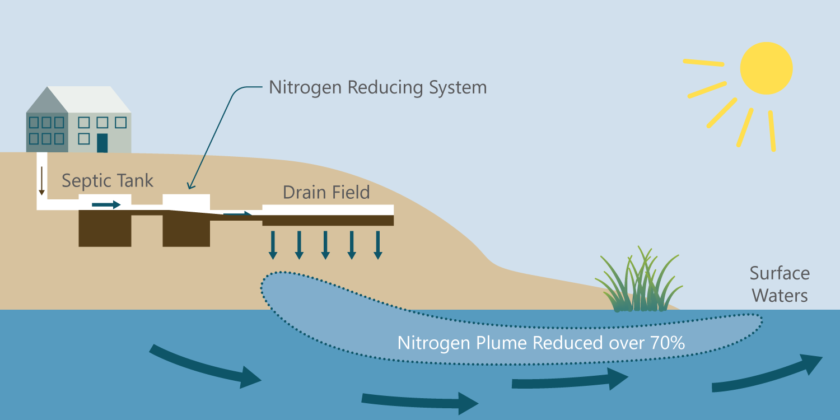Protecting & Restoring Long Island's Peconic Bays

Decentralized STP location is limited to areas where the highest recorded groundwater level is at least 1 foot below the ground surface elevation and cannot be located in steep slope areas (greater than 15%), erosional areas, meadow mat, bog, silt, clay, or other impervious soil areas, areas subject to flooding or improper drainage, limited access areas, and areas expected to create a public health risk (Suffolk County 2017b). In addition, cluster systems must comply with SCDHS setback requirements, including distances to habitable and non-habitable structures and to the property line. The distances are reduced with the installation of odor control systems (Suffolk County 2017b).
The following permits are required for installation of decentralized sewage treatment plants:
The extent of nitrogen removal varies among the different systems, but all approved systems must reduce nitrogen to be below 19 mg/L based on SPDES permit limits.
The influent source for septic systems is septic tank effluent, with a concentration of 65 mg/L (CDM Smith 2020). Effluent concentrations are estimated at 10 mg/L based on the Downtown Mattituck and Shinnecock Shores Pilot Evaluations conducted for the Suffolk County Subwatersheds Plan (CDM 2020). The Downtown Mattituck and Shinnecock Shores STPs were designed to treat 30,000 and 79,000 gpd, respectively (CDM 2020).
Decentralized STP Nitrogen Effluent Concentrations, Nitrogen Reduction, and Annual Removal Rates
| Technology | Effluent Nitrogen Concentration (mg/L) | Nitrogen Reduction (%) | Annual Nitrogen Removal (lb/yr) |
|---|---|---|---|
| Decentralized STP | 9.43 – 10.5 | 85 | 5,015–13,206 |
Capital and operations and maintenance costs and nitrogen benefit assumptions are detailed in Suffolk County (2021) and are based on a 4-bedroom household (440 gpd). Capital costs include a design and engineering cost of $2,500 and are provided for the three types of installations, with reuse of existing leaching structure, and with replacement with either a gravity leaching structure, or a pressurized drainfield. An additional $500 for backfill is added to capital costs for scenarios that replace the existing leaching structure. Operations and maintenance (O&M) costs include power, and consumables, and parts repair and replacement over 20 years with a 2% inflation rate applied. Electric power costs are based on $0.22 per kilowatt hour (kWh; Suffolk County 2020c). The total annualized costs include capital costs annualized with a 5% discount rate and the annual average O&M cost. The cost range includes the least and most expensive vendor referenced for each technology by Suffolk County through the Septic Improvement Program website (https://reclaimourwater.info/SepticImprovementProgram.aspx).
Individual I/A OWTS Capital, O&M, Total Annualized Costs, and Costs per Pound of Nitrogen Removed
| BMP Type | Capital Cost | Average Annual O&M Costs | Total Cost* | Cost per Pound N Removed |
|---|---|---|---|---|
| Decentralized BMP | $7,936,249–$18,882,781 | $109,338–287,923 | $746,163–1,803,127 | $137–$149 |
Sign up for News, Events and Information straight to your inbox.
